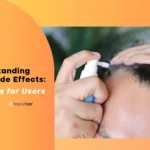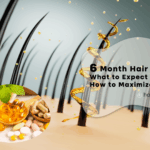Hair Growth Phases Explained: How Your Hair Naturally Cycles

The natural hair growth cycle is a fascinating process that causes your hair follicles to produce new, healthy hair strands. If you’re dealing with hair thinning and loss, or just want to understand hair growth cycles – this article is for you. We’ll dive into each stage of the hair growth cycle, including the anagen phase, catagen phase, telogen phase, and exogen phase. This will help you better understand the key causes of hair loss and how you can promote regrowth. Let’s get started!
What is the Hair Growth Cycle?
The hair growth cycle is a natural process that consists of 4 main phases: anagen, catagen, telogen, and exogen. Each strand goes through each of the hair growth phases which cause growth, rest, and shedding. The cycle keeps hair balanced and maintains a full head of strong, healthy hair under normal conditions.
4 Different Hair Growth Phases
Each phase plays a key role in supporting healthy hair growth. Here’s a breakdown of how the phases work:
Anagen Phase
This is the active growth phase. Hair follicles are actively producing new cells, causing hair to grow longer. The hair follicles push hair up through the skin as a result of cells in the hair bulb dividing rapidly. This phase normally lasts between 2 and 7 years based on several factors like your genetics, age, and overall health. The longer the anagen phase, the longer your hair grows.
Catagen Phase
Once the anagen phase is complete, hair follicles enter the catagen phase. It’s a short transitional period that lasts about 2 weeks and signals the end of the active growth phase. Hair follicles shrink and detach from the blood supply, preparing the hair for the next phase. This is an essential stage for regulating hair growth, as it maintains a steady number of hairs growing on the scalp and prevents them from shedding at the same time.
Telogen Phase
This is often referred to as the resting phase of the hair growth cycle. It usually lasts around 3 to 4 months. During this phase, hair doesn’t grow anymore but stays attached to the scalp while the hair follicle rests. The resting phase stops hair from shedding straight after the growth phase. Hair loss and health conditions can cause more hairs to remain in the telogen phase, leading to increased shedding and potential thinning.
Exogen Phase
The exogen phase is actually an extension of the telogen phase. Old hair eventually sheds to make room for new hair growth. This type of shedding is normal, and the phase lasts for around 2 to 5 months. Old hair detaches from the hair follicle and prepares for a new anagen phase. If hair shedding is excessive in this stage, it could suggest a problem with the hair growth cycle.
[elementor-template id=”9678″]
What Factors Can Influence the Hair Growth Cycle?
Many factors can affect the health and duration of the hair growth phases. Here are some of the most common:
- Genetics – Your DNA determines how long each phase of the hair growth cycle lasts.
- Age – As you grow older, hair growth cycles may shorten and some hair follicles can stop producing new hair altogether.
- Hormones – Hormonal changes can disrupt normal hair growth cycles. For example, hormonal imbalances due to thyroid issues have been linked to hair loss.
- Diet – A poor diet can impact the hair growth phases. Getting enough essential vitamins is important for supporting healthy hair growth.
- Stress – Chronic stress can push more hair into the telogen resting phase or exogen phase, leading to increased hair shedding.
- Health Conditions – Certain medical or scalp conditions can cause problems with the natural hair growth cycle.
- Hair Loss Conditions – Male pattern baldness (androgenetic alopecia) and other hair loss conditions can impact the cycles and other growth factors.
What Can You Do To Support The Hair Growth Cycle?
There are many things you can do to support the hair growth cycle, prevent thinning, and encourage regrowth. Make sure to eat a balanced diet, with plenty of protein and vitamins like biotin, vitamin D, and iron that promote healthy hair growth. You should also manage your stress levels to avoid telogen effluvium, or stress-induced hair loss. Take care of your scalp by keeping it clean and hydrated, as this provides an optimal environment for regrowth.
Also, make sure to get regular trims and adopt a good hair care routine. Try to avoid damaging your hair. You can do this by reducing heat styling, avoiding harsh treatments, and protecting your hair from environmental factors like sun exposure and pollution. Another option is to consider the wide range of hair loss treatments available, which can help support the hair cycle.
[elementor-template id=”9673″]
Explore Hair Loss Treatment Options
If you’re experiencing issues with the hair growth cycle, many treatments are available that can reduce thinning and improve growth. They influence the hair cycle in a variety of ways, such as causing a prolonged anagen phase. Let’s take a look at some of the most popular hair loss treatments on the market.
Hair Loss Medications
The most common hair loss medications are minoxidil and finasteride. Minoxidil works by increasing blood supply to the hair follicles, delivering more oxygen and essential nutrients to stimulate follicles and promote thicker, healthier hair growth. Topical minoxidil can be purchased over-the-counter or online and generally comes in foam or spray form. Finasteride is a prescription-only medication that works by blocking DHT, the hormone that causes hair follicles to shrink. With reduced DHT levels, the follicles can continue growing hair as normal.
Growth Serums/Shampoos
Hair growth shampoos and serums contain many useful ingredients that nourish hair follicles and improve overall scalp health. Ingredients like biotin, peptides, and amino acids support increased hair density and resilience. They can prevent hair breakage and encourage a prolonged anagen phase. Regularly using hair growth products can help you grow longer, thicker hair by supporting each hair shaft throughout the cycle.
Low-Level Laser Therapy (LLLT)
This non-invasive procedure uses low-level lasers to stimulate hair follicles and boost blood supply to the scalp. LLLT can promote healthy hair growth by energising hair follicles and encouraging them to enter the active growth phase. It can also reduce the time spent in the exogen phase, reducing shedding and increasing regrowth.
Hair Transplant Surgery
Surgical options are generally used for conditions like male pattern baldness, or when other treatments don’t work. Transplantation involves moving hair follicles from healthy areas of the scalp to areas affected by thinning. When they have been transplanted, hair follicles continue the natural hair growth cycle.
The Hairy Hair Treatment Plan
The Hairy Hair treatment plan is a convenient and effective solution to hair loss. It’s designed to tackle the root cause of hair loss at the follicle level. Treatment is formulated by GPs who specialise in hair growth, with a unique combination of clinically proven ingredients. You don’t need to visit a clinic – simply sign up for a subscription and we’ll deliver our expertly formulated ingredients straight to your doorstep. You’ll also have access to ongoing support from our team of experienced doctors. Hairy Hair boosts natural hair growth cycles to slow thinning and promote real, lasting regrowth.
Final Thoughts
The hair growth cycle is a complex process that involves 4 different phases – anagen, catagen, telogen, and exogen. Each phase plays an important role in maintaining healthy hair growth. However, many factors can impact these phases and lead to hair thinning and eventual loss. Now you have a stronger hair growth understanding, you should be able to identify issues with your growth cycle and select the most effective treatments. By taking a proactive approach, you can support each phase of the cycle and experience lasting hair health and regrowth.
Discover more on our website!
In This Article
Overview
Most Trending Articles


